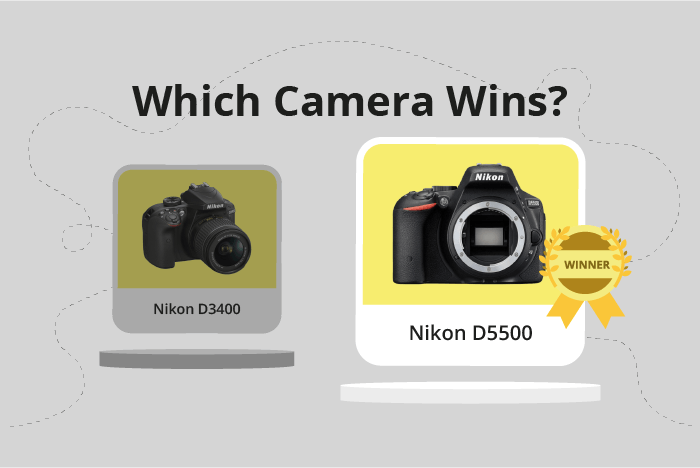Nikon D3400 vs D5500 Comparison
Nikon D3400

Nikon D5500

The Nikon D3400 and Nikon D5500 both score 61/100, making them comparable DSLR cameras. They share the same camera type, announcement year, and similar dimensions, with the D3400 measuring 124 x 98 x 76mm and the D5500 at 124 x 97 x 70mm. The D5500 is slightly lighter at 420g compared to the D3400’s 445g.
The D3400 has a lower launch price of $650, making it more affordable than the D5500’s $900. However, the D5500 was released in 2015, a year earlier than the D3400. Each camera has its advantages, with the D3400 being more budget-friendly and the D5500 having a longer market presence. Ultimately, the choice depends on the user’s preferences and budget.
Nikon D3400 vs D5500 Overview and Optics
The Nikon D3400 and Nikon D5500 both score 65/100 in optics, showing no clear winner in this category. They share several specifications, including 24.2 megapixels, a shooting speed of 5 frames per second, a CMOS sensor type, an Expeed 4 processor, an APS-C sensor size, a Nikon F DX lens mount, and a lack of image stabilization.
Despite having the same score, the D3400 has a slight edge in terms of sensor performance, with a DXOMARK score of 86, compared to the D5500’s 84. This means the D3400’s sensor provides marginally better image quality, specifically in areas such as dynamic range, color depth, and low-light performance.
On the other hand, the D5500 does not have any particular advantages in optics over the D3400. Both cameras possess the same specifications in this area, resulting in similar image quality and performance. The D5500 does not offer any additional features or improvements that would give it an edge in the optics category.
In comparing the optics of the Nikon D3400 and Nikon D5500, it is evident that both cameras have similar specifications and performance. The D3400 has a minor advantage in sensor performance, but this difference is not significant enough to declare a clear winner. Both cameras are suitable for users seeking quality optics in their photography.
Nikon D3400 vs D5500 Video Performance
The Nikon D5500 emerges as the winner in the video capabilities comparison, with a score of 70/100, while the Nikon D3400 scores 56/100. Both cameras share common specifications in this category, such as Full HD video resolution, maximum video dimensions of 1920 x 1080, and a maximum video frame rate of 60fps.
The Nikon D5500 outperforms the D3400 in terms of video capabilities primarily due to its built-in time-lapse functionality. This feature allows users to capture stunning time-lapse videos with ease, without requiring any additional equipment or software. This makes the D5500 a more versatile option for videographers looking to add creative elements to their work.
On the other hand, the Nikon D3400 does not have any specific advantages in the video category. However, it is worth noting that the D3400 shares the same core video specifications with the D5500, making it a capable option for standard video recording tasks.
Taking these points into consideration, the Nikon D5500 is the superior choice for those prioritizing video capabilities, offering additional creative possibilities through its time-lapse functionality. The Nikon D3400, while not excelling in this category, remains a viable option for basic video recording needs, sharing the same fundamental specifications with the D5500.
Nikon D3400 vs D5500 Features and Benefits
The Nikon D5500 wins in the features comparison with a score of 59/100, while the Nikon D3400 scores 54/100. Both cameras share common specifications such as a 3-inch screen size, screen resolution of 921,000 dots, and the absence of GPS. However, the D5500 excels in certain aspects that give it an edge over the D3400.
The D5500 has a larger screen size of 3.2 inches and a higher screen resolution of 1,037,000 dots, providing a clearer and more detailed display. Additionally, the D5500 features a touchscreen, making navigation and menu selections more efficient. The D5500 also has a flip screen, which is useful for capturing images and videos from various angles. With built-in WiFi, the D5500 allows for easy sharing and transferring of files, a feature that the D3400 lacks.
On the other hand, the D3400 has Bluetooth connectivity, enabling remote control of the camera and seamless file transfers to compatible devices. This is a feature that the D5500 does not possess. However, this advantage does not significantly impact the overall performance and usability of the cameras.
In the features comparison, the Nikon D5500 proves to be a better choice due to its larger screen size, higher screen resolution, touchscreen, flip screen, and WiFi connectivity. The D3400’s advantage of having Bluetooth connectivity does not outweigh the benefits provided by the D5500’s superior features. Therefore, the Nikon D5500 is the winner in this comparison.
Nikon D3400 vs D5500 Storage and Battery
The Nikon D3400 emerges as the winner in the storage and battery category with a score of 45/100, while the Nikon D5500 trails behind with a score of 35/100. Both cameras share some specifications, such as having a single memory card slot and accepting SD, SDHC, and SDXC memory cards. Neither camera offers USB charging.
The Nikon D3400 outperforms the D5500 in battery life, providing 1200 shots per charge with its EN-EL14a battery, compared to the D5500’s 820 shots using the EN-EL14 battery. This longer battery life makes the D3400 a more reliable option for extended shooting sessions.
However, the Nikon D5500 does not have any advantages in storage and battery over the D3400. As a result, the D3400 proves to be the superior option in this aspect, offering greater reliability and endurance for photographers who prioritize extended battery life.
Nikon D3400 vs D5500 – Our Verdict
Are you still undecided about which camera is right for you? Have a look at these popular comparisons that feature the Nikon D3400 or the Nikon D5500:

